The truth: finding keywords is easy.
There’s hundreds of free and paid search engine optimization (SEO) tools that will spit out keyword suggestions and recommendations by the thousands.
The hard part is finding out whether or not those keywords are worth pursuing.
Are they rankable?
Do they have enough search volume?
Will they lead to sales?
In this article, we’ll explore the strategic underpinnings of sound keyword selection. Because there’s a difference between knowing how to find keywords and knowing how to choose the best keywords. And that difference can make or break your SEO strategy.
Let’s go.
- How to choose the right keywords for SEO
- 1. Identify monthly search volume
- 2. Assess keyword difficulty
- 3. Determine if you can satisfy search intent
- 4. Analyze authority of page one results
- 5. Select brand and activation keywords
- 6. Estimate organic click-through rate (CTR)
- 7. Find out if you’re already ranking for it
- Wrapping up choosing keywords for S
Get brand new SEO strategies straight to your inbox every week. 23,739 people already are!Sign Me Up
How to choose the right keywords for SEO
Choosing the best, most relevant keywords for SEO starts with good keyword research.
If you want to choose the right keywords, first you need a long list of potential candidates.
There are dozens of great keyword research tools available for all different price points (including free versions). And all of them do a great job of providing keyword ideas.
But since SEO keyword research is a loaded topic, we decided to write an entire article on it: Keyword research for SEO.
Once you have your list of keyword candidates, the difference between choosing good keywords and choosing bad keywords comes down to answering seven simple questions:
- Is there enough search volume?
- Is it rankable (not too competitive)?
- Can I satisfy the searcher’s intent?
- Do I have the domain authority to outrank opponents?
- Will it lead to sales now? Or sales later?
- Will I get clicks if I rank? Or will Google hoard them?
- Am I already ranking for it?
Let's dive into each.
1. Identify monthly search volume
Will the keyword drive enough traffic?
There’s no point in investing thousands of dollars to rank for keywords that drive no traffic to your website.
That’s not to say every keyword you pursue needs to have a high search volume. It doesn’t. But in general, the lower the search volume, the higher you’ll want the commercial intent to be. For example, if a target keyword is only going to drive 10 monthly visitors, they better all be looking to buy (or subscribe, download, demo, etc.)
One problem: search volume data is not created equal. In fact, from tool to tool, search volume data varies wildly.

Why is search volume so inconsistent?
For starters, Google no longer provides free access to exact search volume data (well, more accurate is a better way to describe it than exact). They only provide ranges ( “groupings”) and many SEO tools use free Google data as a starting point when building their search volume estimates.

Keyword: Estimates.
In the absence of accurate data, tools are left to estimate “precise” monthly search volume. So they use a combination of clickstream data, Google Keyword Planner forecast data, and user data (e.g. access to a user's Adwords account) to do it. Hence the variations in estimates from one tool to the next.
This poses a big issue when choosing which keywords to prioritize.
For example, say you want to pursue two different keywords, both with “10K-100K” monthly searches. But one of those keywords actually gets searched 99,999 times and the other actually gets searched 11,597 times. Big difference. The lack of precision could cost you thousands over the long haul.
Good news: there’s a hack.
To find more precise search volume, head over to Google’s Keyword Planner (accessed through your Google Ads account). If you haven’t created a Google Ads account yet, you can do it for free.
Once logged into Keyword Planner, select “Get search volume and forecasts.”

Next, add the list of keywords you want to find a more precise search volume for, then click “Get started.”

From there, you’ll see a screen with your selected keywords and their average search volume buckets. We don’t care about this number. We want to drill deeper.
Now, click on the “Forecast” tab in the top left.
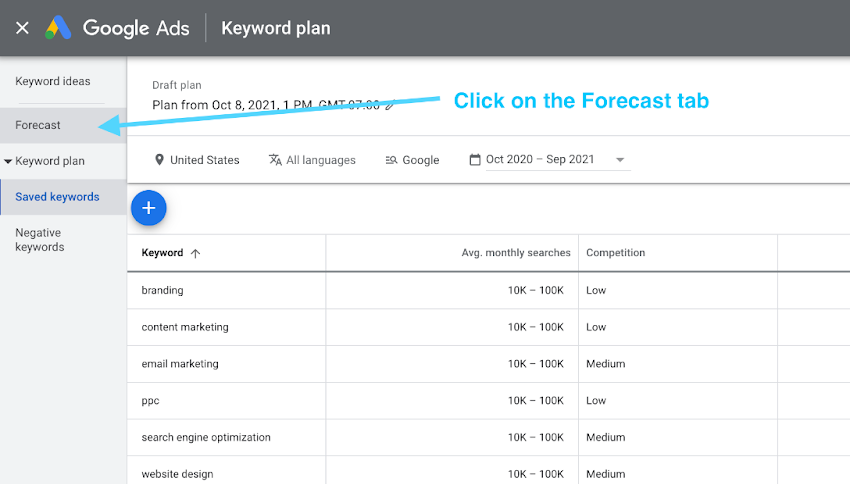
This is where the fun begins.
From the “Forecasts” panel, change the max CPC to the highest possible in your currency. In this case, it’s $100 max CPC.
Why change it? Though still not 100% accurate, by changing the max CPC to the highest possible, you’re telling Google to surface the most possible impressions (since impressions won’t be limited by cost), which gets you closest to real-life organic impressions.
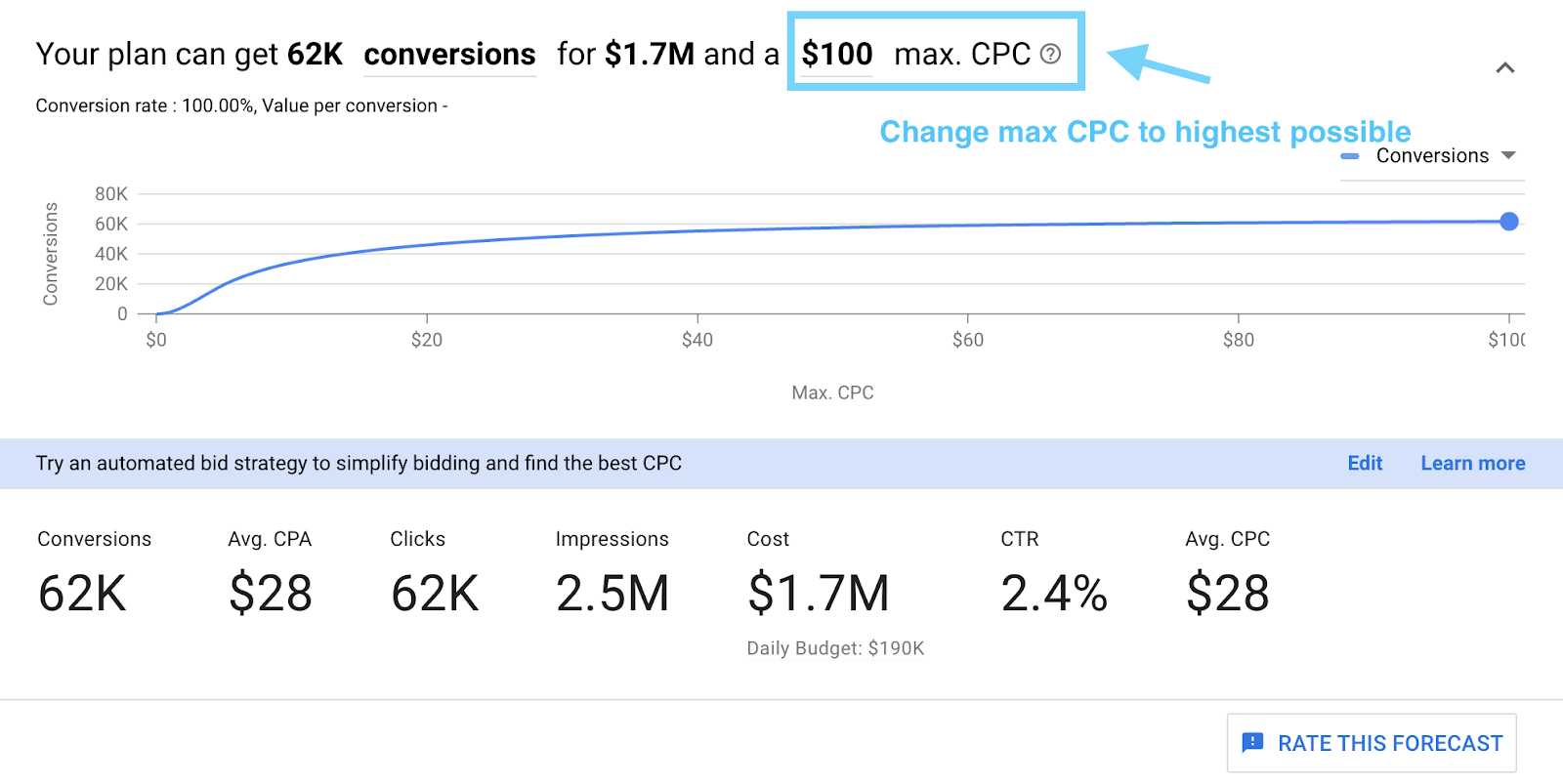
Now scroll down and look at the “Impressions” column.
Boom 🤯 this is your precise search volume data.

How do these impressions differ from the earlier estimates Google suggested? Let's take a look again.
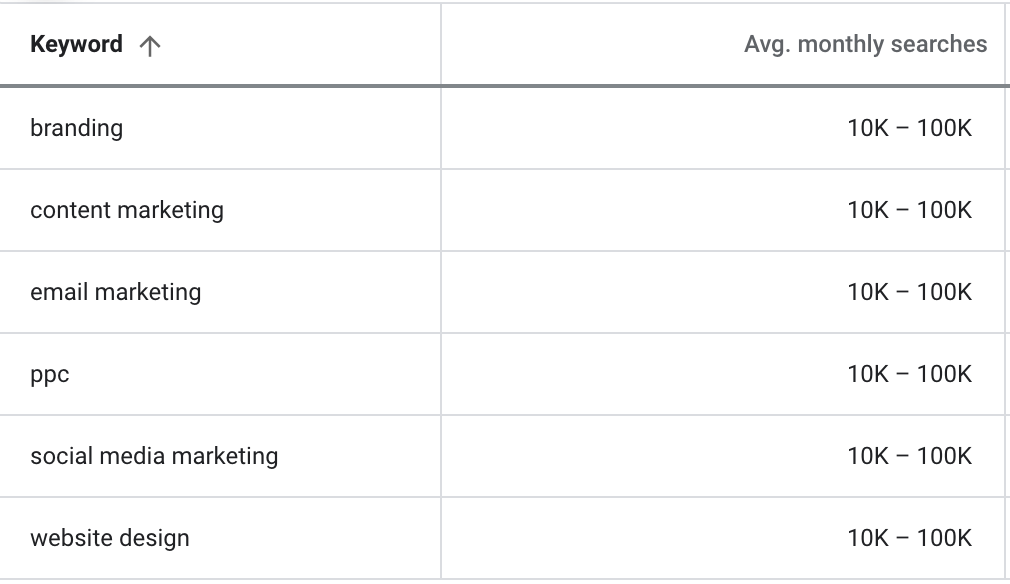
Branding: Was 10K-100K; Now is 117,268
Content marketing: Was 10K-100K; Now is 138,840
Email marketing: Was 10K-100K; Now is 736,563
PPC: Was 10K-100K; Now is 46,690
Social media marketing: Was 10K-100K; Now is 459,327
Website design: Was 10K-100K; Now is 622,580
Umm… wow, right? Not even close.
Now let’s compare our new estimates with a tool like Ahrefs.

Branding: Google 117,268; Ahrefs 541K
Content marketing: Google 138,840; Ahrefs 115K
Email marketing: Google 736,563; Ahrefs 130K
PPC: Google 46,690; Ahrefs 186K
Social media marketing: Google 459,327; Ahrefs 225K
Website design: Google 622,580; Ahrefs 216K
Again, not even close.
But we’re not done. There are two more steps to getting more accurate search volume data.
Next, use Google Trends to check the seasonality and rising/falling popularity of your keywords. Remember, keyword tools and Google use averages, which don’t account for seasonality or downward/upward trending search terms.
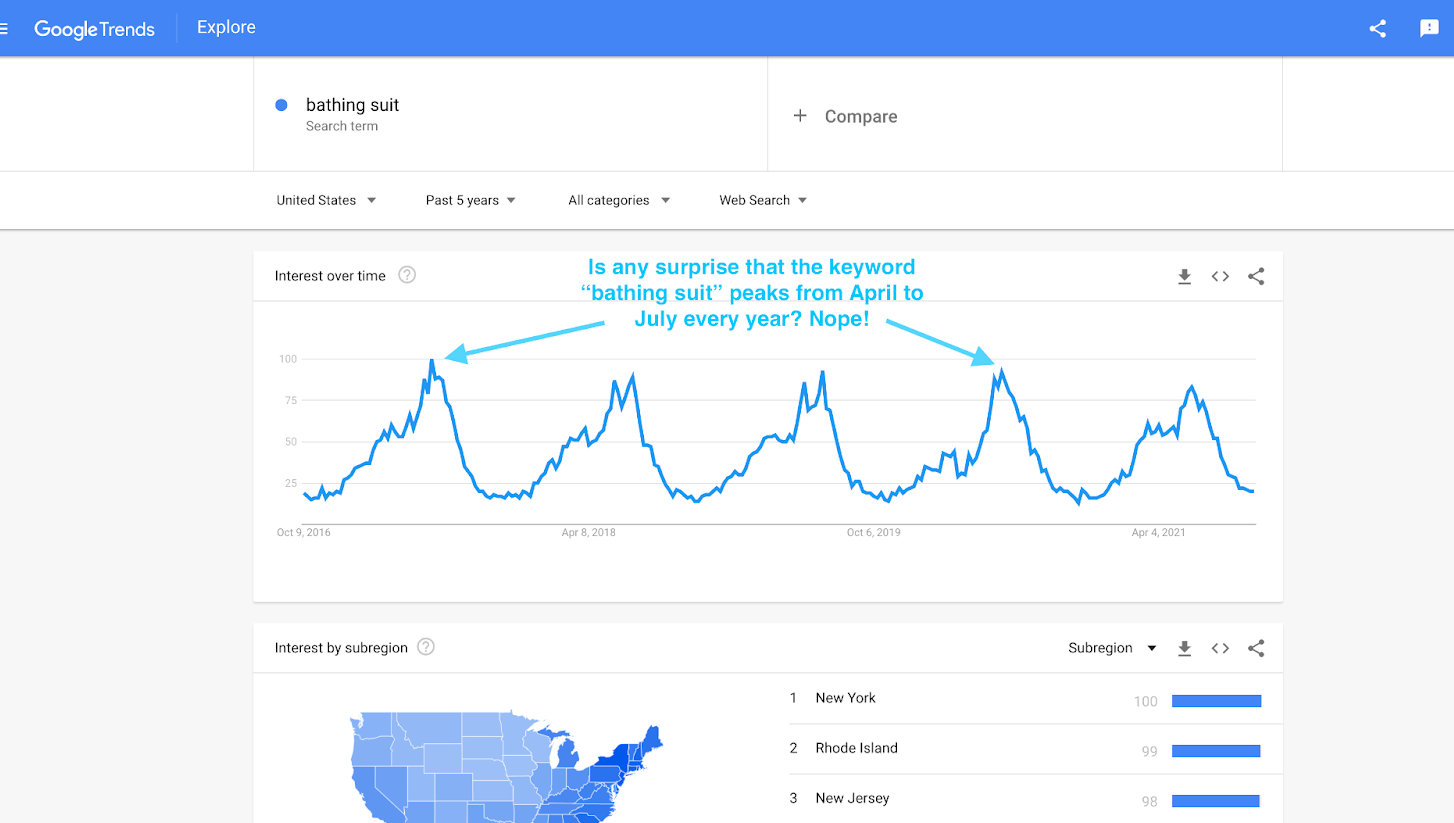
Lastly, once you start ranking for keywords, you can visit Google Search Console where they’ll give you the exact organic impressions each page receives. Now you can compare this definitive data with keyword tools and Google’s Keyword Planner.
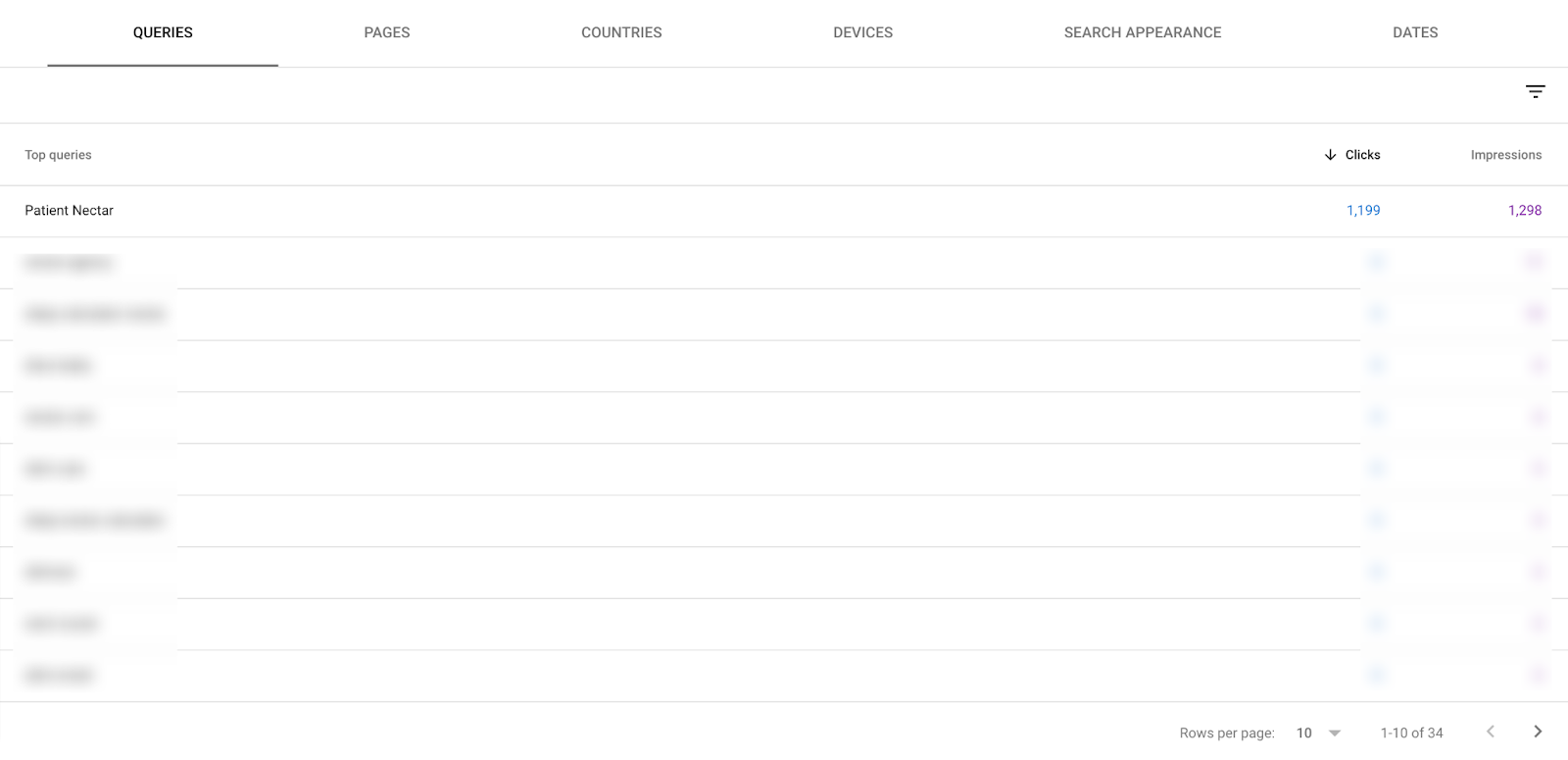
As you can tell, search volume isn’t a perfect science. Far from it.
But if you follow the process above, you can get pretty close. Close enough to make strategic decisions about how to choose keywords and which keywords to prioritize.
2. Assess keyword difficulty
Is it rankable?
The last thing you want to do is attempt to rank for a keyword that isn’t rankable given the timeframe and resources at your disposal.
For example, if you’re a fairly new business or blog, but want to rank for a competitive keyword like “content marketing,” it's not going to happen. There’s too much competition with high domain authority and millions of backlinks.
Thankfully, keyword research tools provide keyword difficulty scores that tell you the degree of competition.
Rule of thumb: The more search volume or higher purchase intent (or both), the more competitive.
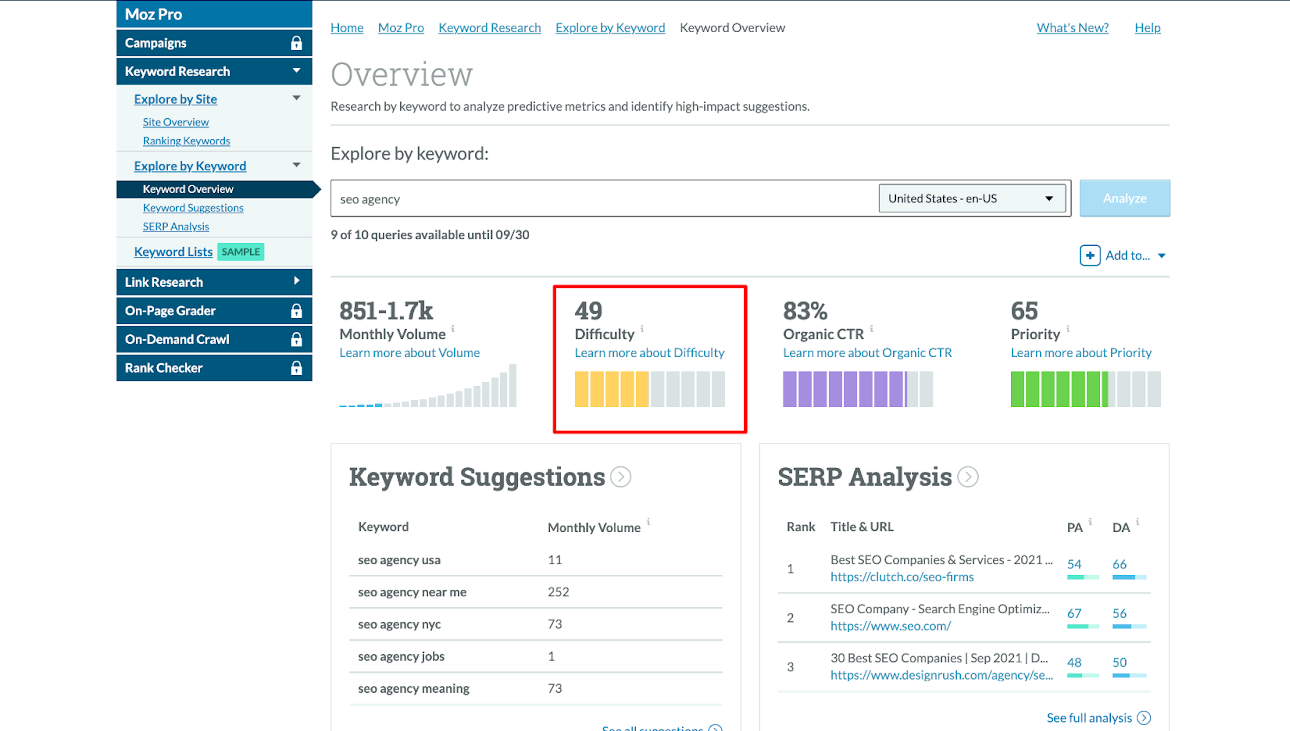
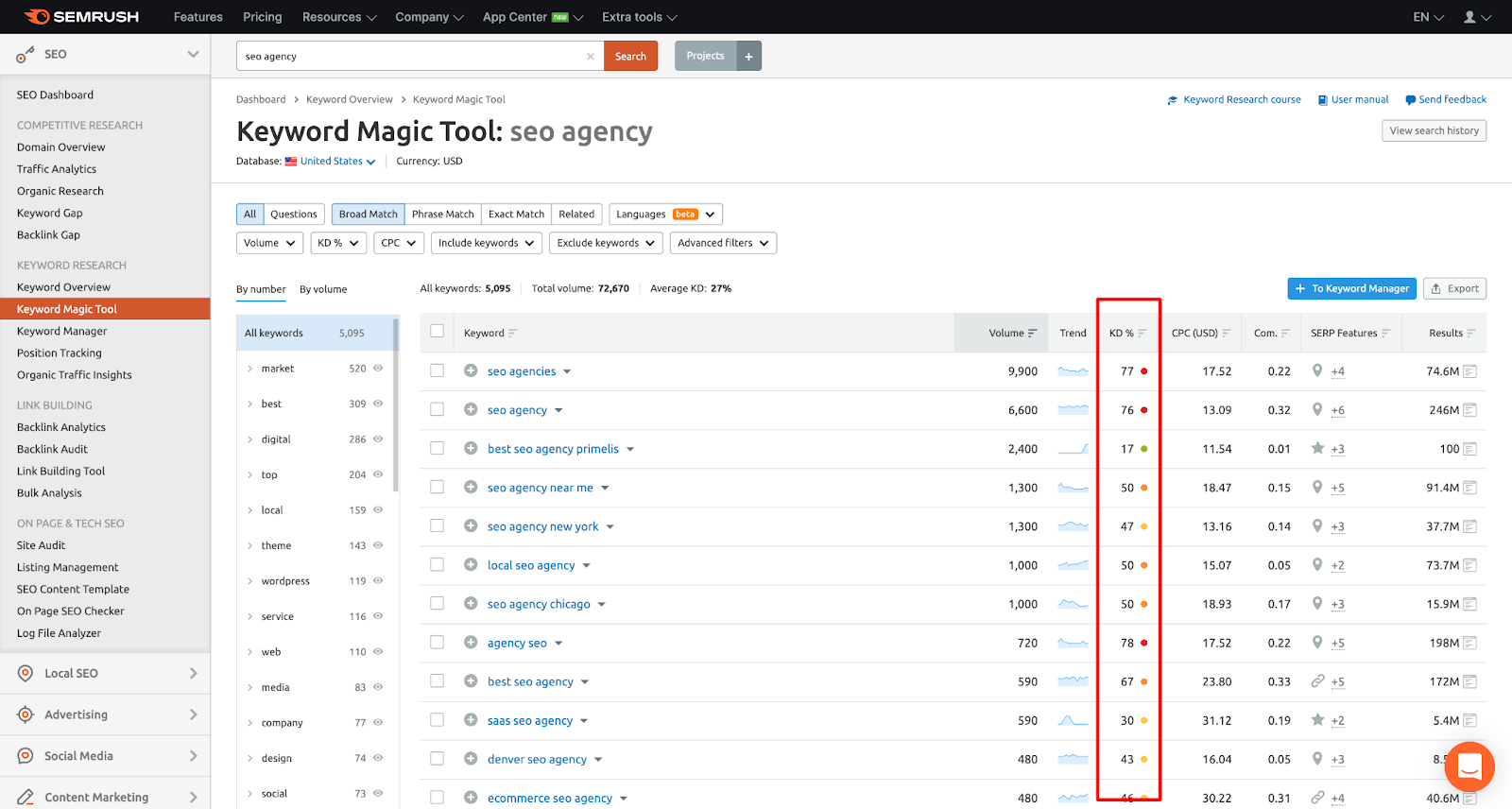
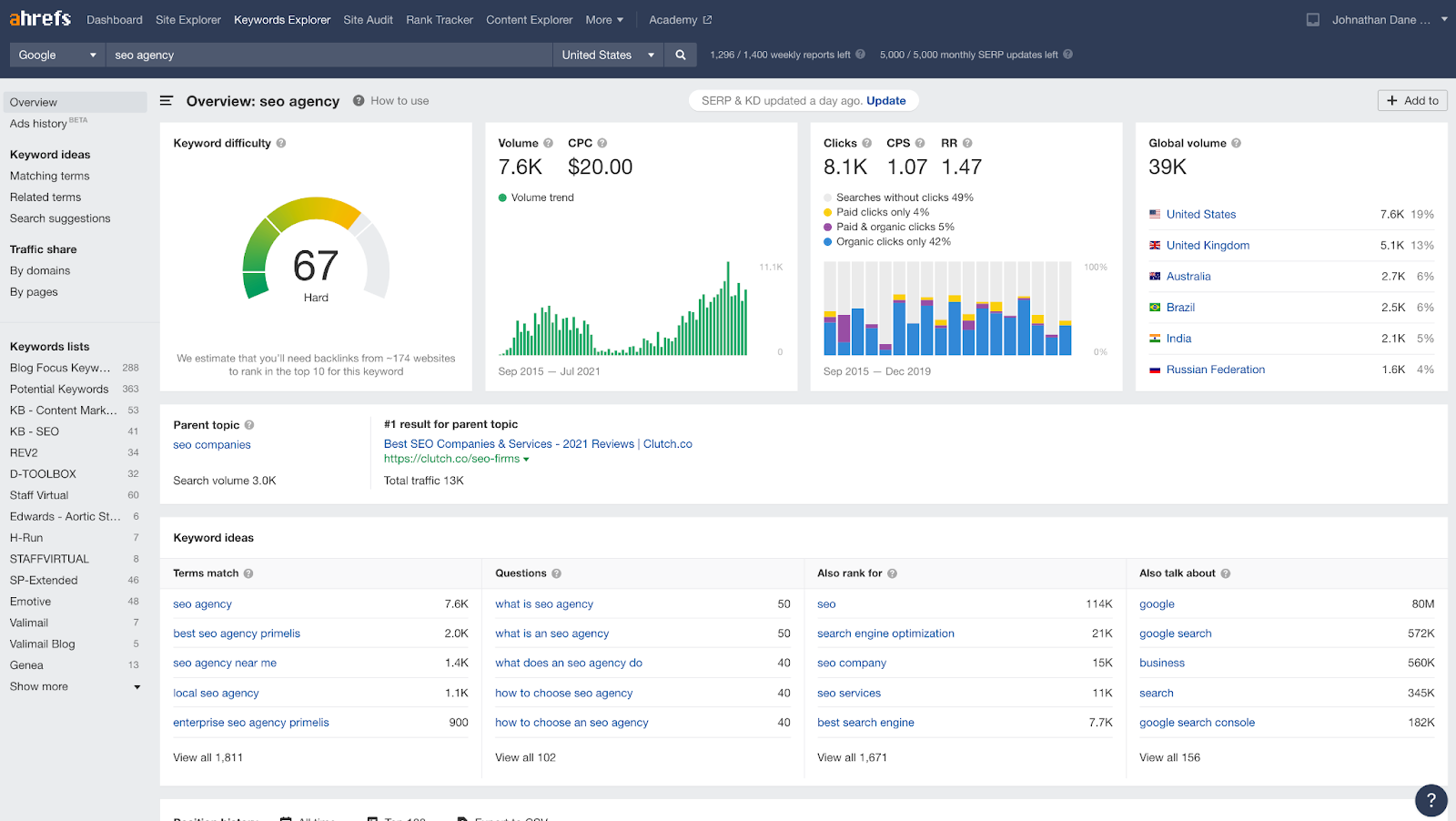
When assessing keyword difficulty, prioritize keywords with high search volume and low competition. More often than not, these will be long-tail keywords.
Also, remember that keyword difficulty is largely based on the number of backlinks a page receives. But there’s a tremendous amount of difficulty that goes into creating a piece of content capable of receiving backlinks to begin with.
If you want to learn more about keyword difficulty, we wrote an entire article on it: Keyword Difficulty: Why It Matters and How to Measure It for Free.
3. Determine if you can satisfy search intent
Can I provide the answer (in the right format) people are seeking?
Google knows exactly what users intend on finding when they type in a query.
Do they want to buy? Do they want to learn? Do they want a tool? Do they want a list?
Google knows.
Sure, using a keyword difficulty tool will tell you how many backlinks you’ll need to acquire to rank. But are you confident you can meet the content, media, and expectation requirements to rank on page one too?
To do this, manually analyze page one results (one by one) and look for the following:
- Content type: Article? Video? Infographic? List? Case study? Data? Tool?
- Content depth: Long-form? Chapter guide? Short-form? Beginner? Advanced?
- Query intent: Navigational? Transactional? Informational? Local? Commercial?
Let’s explore.
Content type, format, depth
Say the article only has a 44 difficulty score in Moz. But the top pages in SERPs (search engine results pages) are custom-built tools, only you don’t have the resources to build your own. In actuality, that 44 becomes a 100.
A perfect example of this scenario is the search term “keyword tools.” 8 out of 10 page one results are actual keyword tools; only 2 are lists.
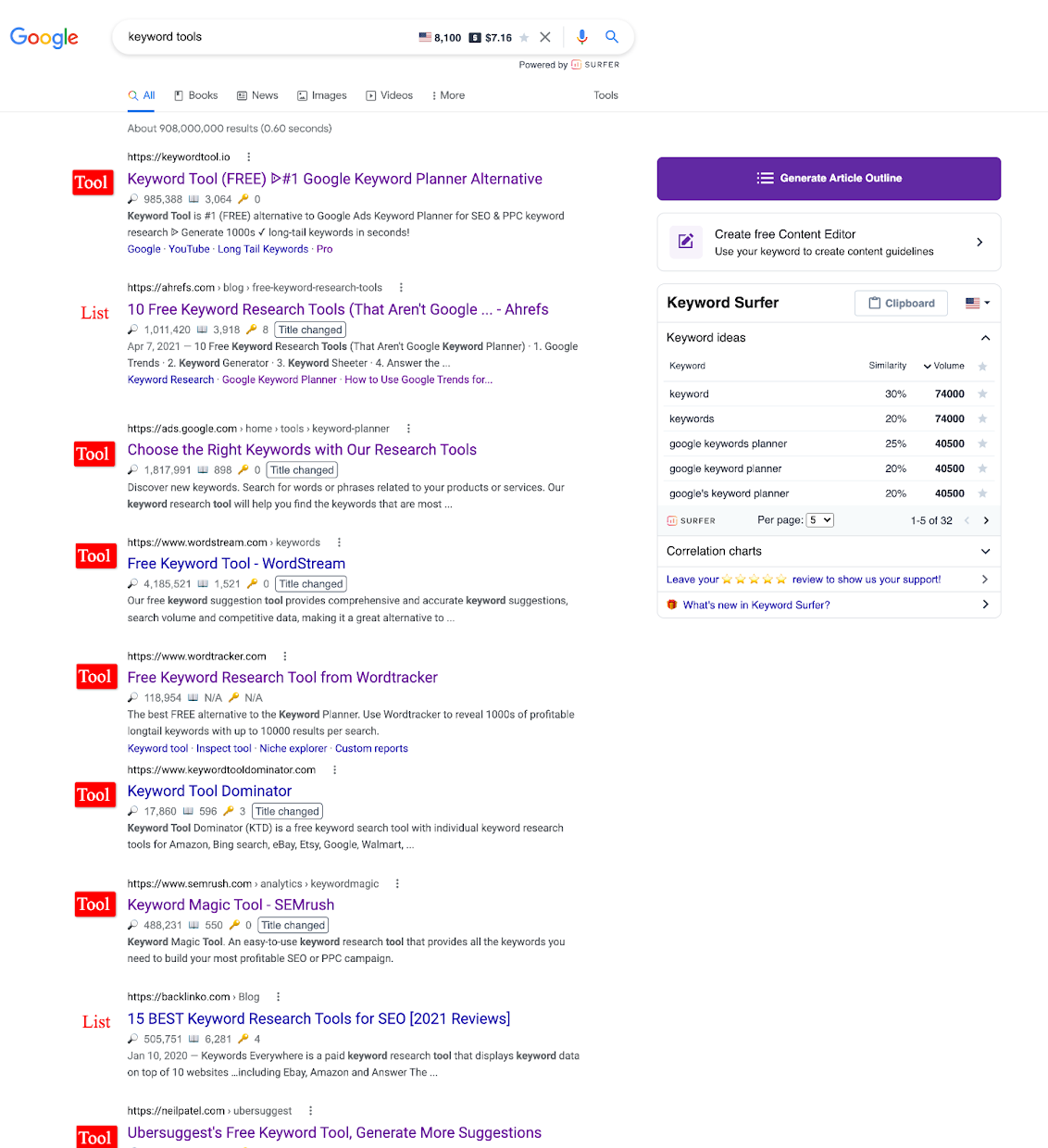
Another example is when Google identifies that searchers expect to find a list of credible review sites or directories, like Clutch.co.

To rank #1 for “SEO agency,” you would need to rank on Clutch.co’s top 10 list. We call this barnacle SEO: when you rank on a third-party site because it ranks higher.
In this scenario, sure, it may sound nice to rank for “SEO agency,” but do you have the resources to rank on Clutch.co’s list?
Query intent
Then there’s query intent– aside from the content type or format visitors intend on finding, are you certain you can provide the answer they intend on finding?
- Is the query navigational? Are they looking for a page on a website they already know exists?
- Is the query transactional? Are they looking to take action, like make a purchase?
- Is the query informational? Do they want to learn something new?
- Is the query local? Are they looking for a local business near them, not a global provider?
- Is their query commercial? Are they investigating a product or service?
For example, when someone searches for “freelance writing,” most page one results show websites that post freelance gigs or hire freelance writers. This is a transactional query (searchers expect to take action). To rank high, you’ll likely need a freelance service to sell, not just an article talking about freelance writing.
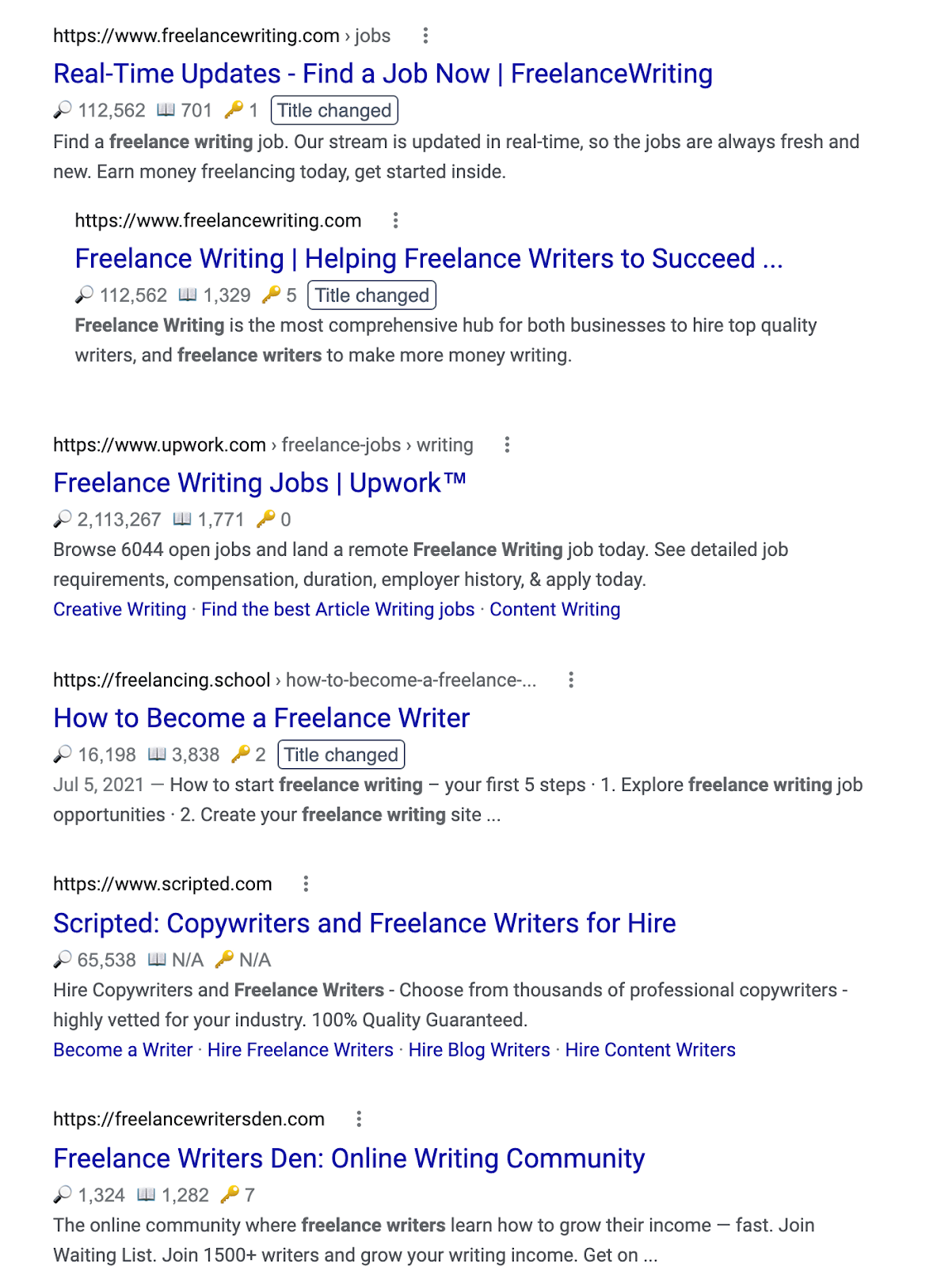
4. Analyze authority of page one results
Do you have the domain authority or page authority to outrank opponents?
What’s domain authority (DA)? It’s a score (0-100) invented by MOZ that estimates how likely it is for a website to rank in SERPs. Like keyword difficulty, domain authority also looks at link profile (quality and quantity of backlinks) and other factors, only at the domain level.
What’s page authority (PA)? It’s like domain authority, only scored at the page level.
While neither are ranking factors, both are strong indicators of the likelihood to rank.
(P.S. We wrote an entire article on domain authority if you want to take a deep dive.)
How do you find DA and PA and why does it matter?
First, you can find both by installing MOZs free browser extension (Chrome and Firefox). After you download and install MOZbar, simply type in a query in Google and compare the authority of top ranking websites (the tool will populate scores below SERP snippets).
Also, tools like Ahrefs and SEMRush have their own versions of domain authority, called Domain Rating and Authority Score, respectively.
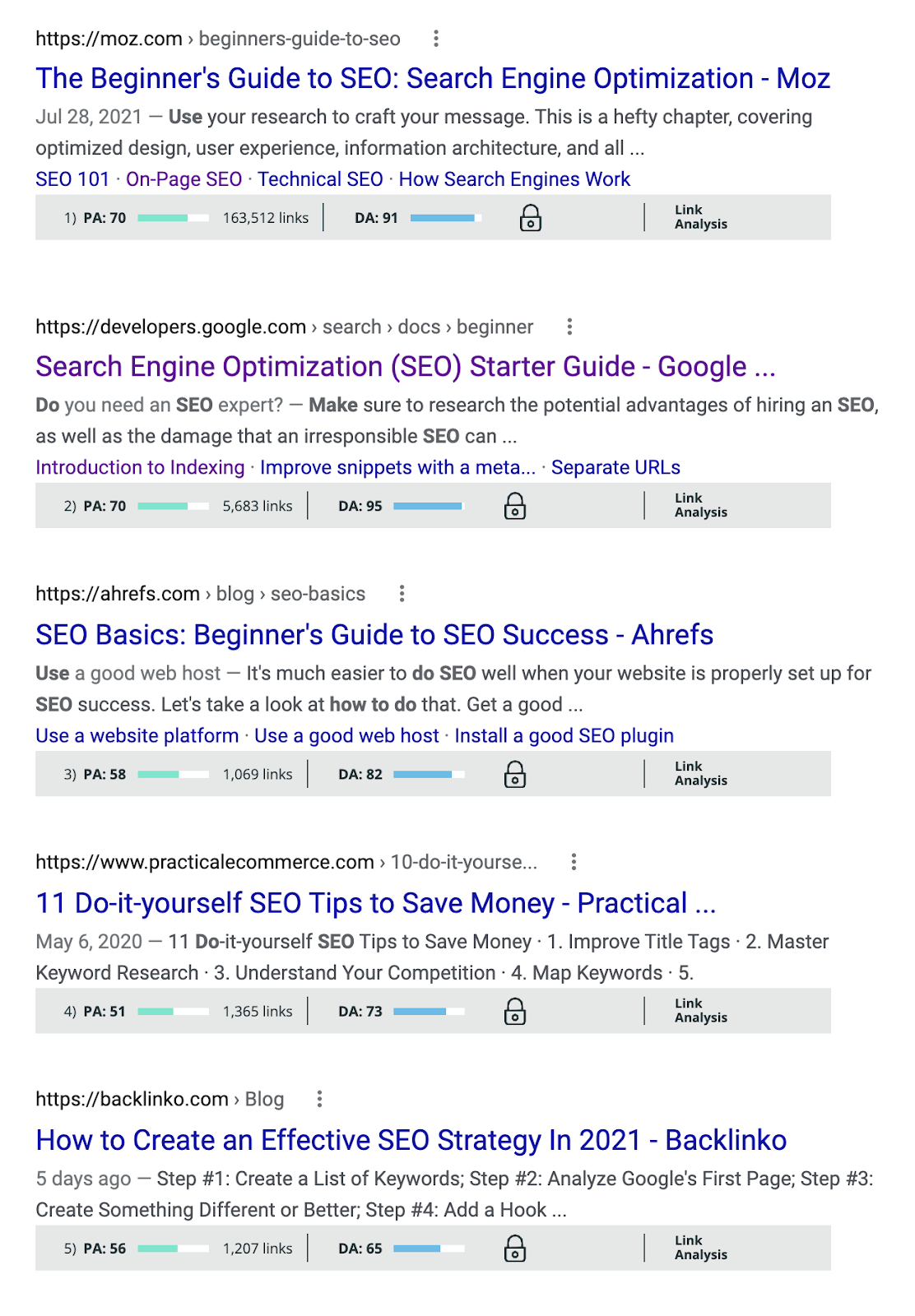
Why does DA and PA matter?
Bad news: If page one is filled with high DA websites (DA50+), and your site is DA 14, you’re probably not going to outrank them. Sorry.
Good news: DA/PA is relative. Certain industries are more link-friendly than others, hence higher DA/PA scores in SEO than lawn fertilizer. Best to use it as a comparative metric. What matters is how your DA/PA compares to competitors in your industry.
Though DA and PA have more in common than not, PA is a better metric to reference since many high DA websites (like YouTube) may have domain authority but not the topical authority required to rank #1.
In general, you’ll want to ensure your DA/PA falls within 20-30 points of those on page one if you expect to rank.
Note: Neither DA or PA account for intent, on-page or content quality. These are all huge ranking factors. So take authority scores with a grain of salt: while a useful comparative metric, they’re not a panacea.
5. Select brand and activation keywords
WIll it lead to sales now? Or sales later?
You can use SEO for brand building (long-term) or sales activation (short-term).
Brand building uses thought leadership to generate awareness, familiarity, and trust with out of market buyers: people who aren’t searching for solutions you provide today, but who may be in the future.
Sales activation uses persuasive/rational content to generate immediate sales from in-market buyers (people who are looking to buy now).
You need both.
And those are the two broad buckets for which you need to choose keywords. (A bit easier to follow than mapping keywords to a metaphorical marketing funnel that everyone hates, right?)
Let’s start with the second bucket: sales activation.
This one is easy: Choose keywords with commercial intent (i.e. a high likelihood that the searcher is going to buy soon).
- Buy red balenciaga heels
- SEO agency vs. in-house
- Plumber huntington beach
- Cheap running shoes
- Compare Macbook laptops
- Best external hard drives
Then for brand building queries, start by choosing keywords from people who are trying to solve the same problems as your services but in all the different ways.
Not only will this ensure you generate awareness with people who are most likely to become potential customers in the future (because they’re seeking to solve problems you solve), but it’s a perfect way to generate demand for problems you solve.
For example, on the KlientBoost blog, we routinely provide novice marketing advice. Not because we expect those visitors to convert anytime soon, but because we know those visitors will likely fit our ideal client profile (i.e. target audience) in the future.
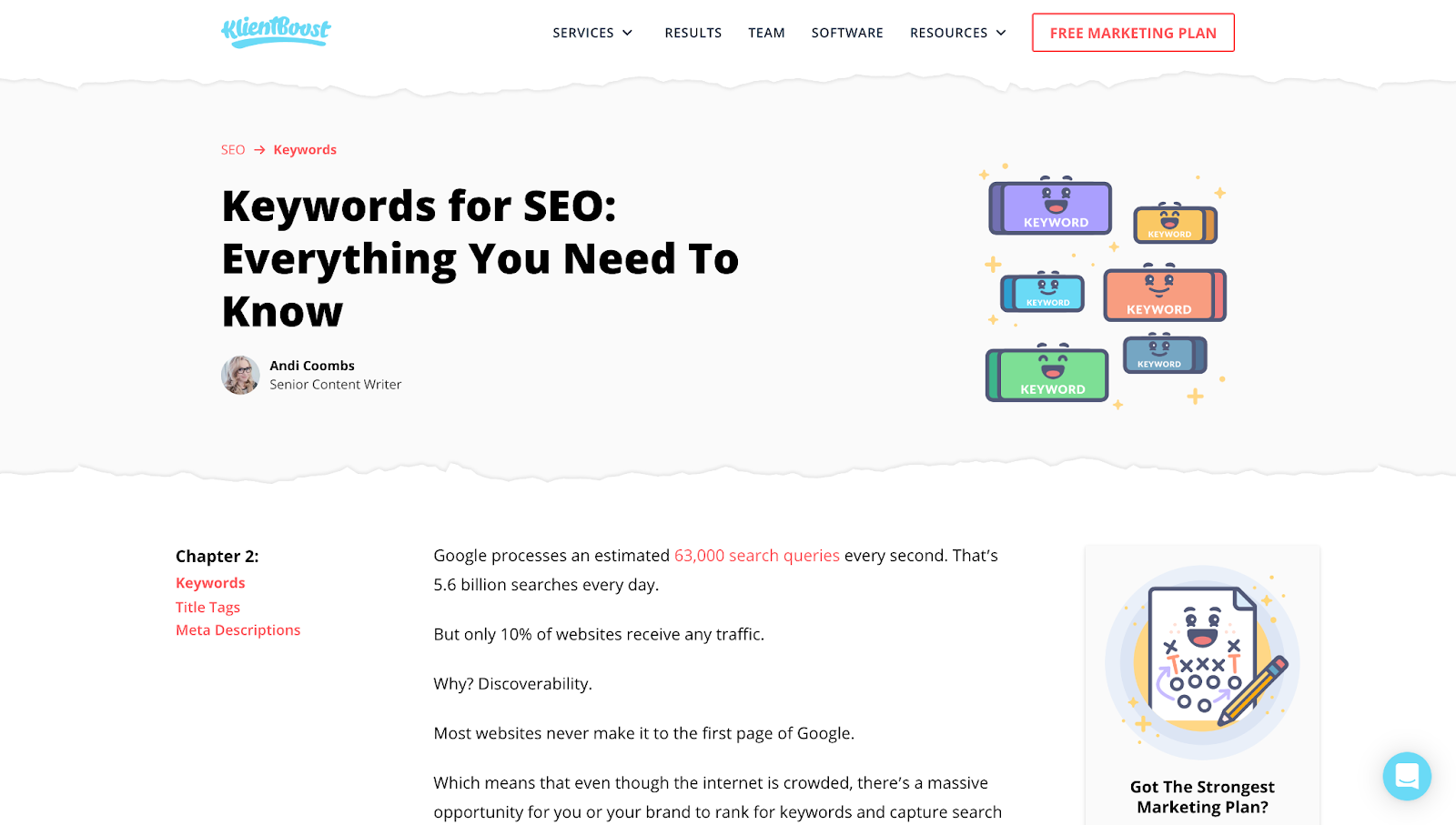
Lastly, whether or not a keyword will lead to sales now (activation) or sales later (brand building) will determine what you do after the click.
For example, for brand-building queries, it makes sense to have a mechanism in place that keeps attention, like an email newsletter.
For sales activation queries, it makes sense to offer clear calls-to-action or additional content that moves visitors down the funnel quicker.
6. Estimate organic click-through rate (CTR)
If I rank, will I get clicks? Or will Google hoard them?
Did you know that 62% of all search queries don’t end with a click? Seriously.
That means more than 2/3rds of all searchers remain inside a Google property and don’t click on organic results after they type in a query.
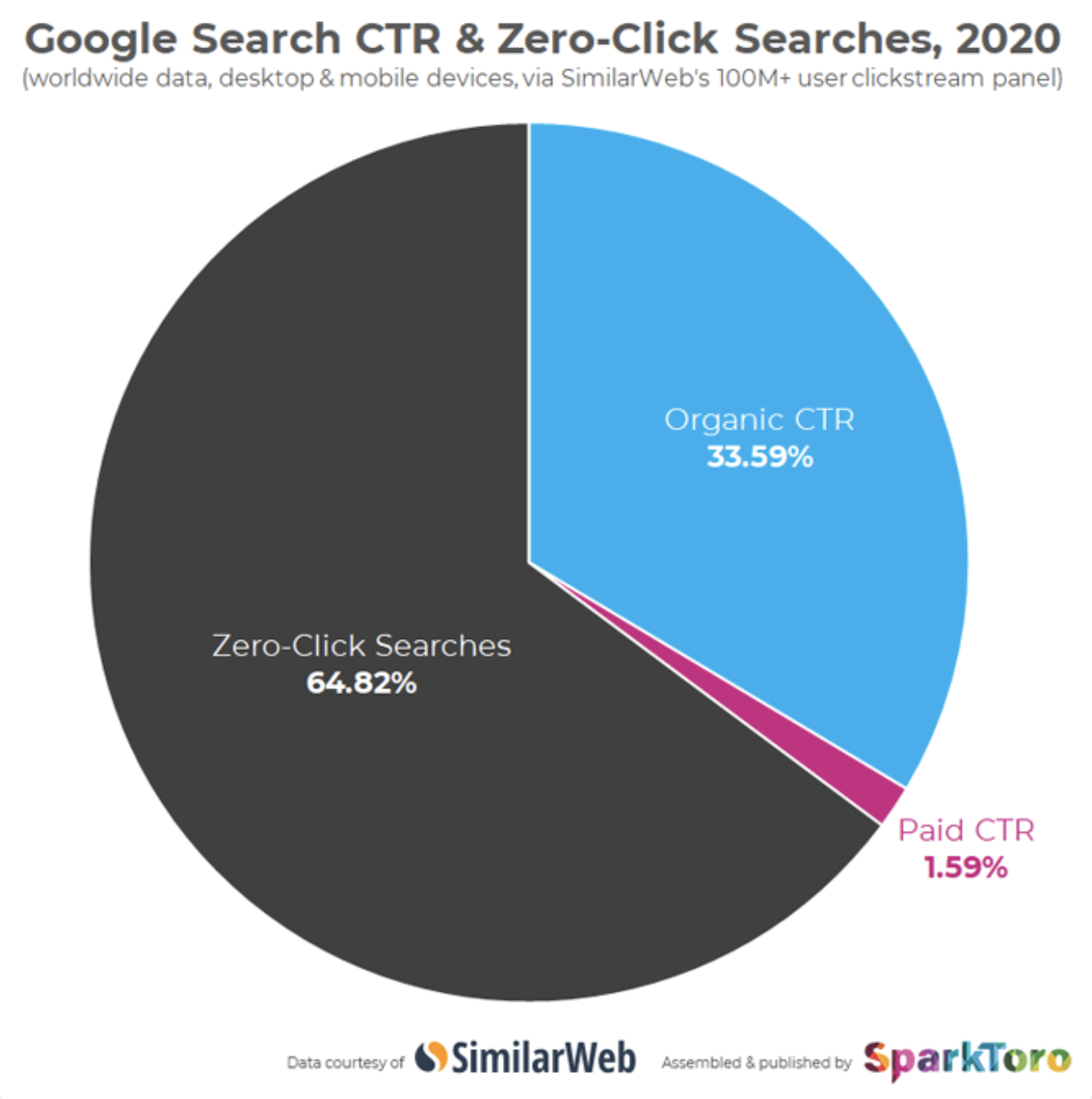
With Google continuing to increase content blocks within the search engine results pages (SERPs), like featured snippets, people also asked, knowledge panels, carousels, and more, it’s worth manually checking SERPs for each query to see how much of the estimated search volume you will actually receive.
First, let’s look at the average CTR for first-page rankings.
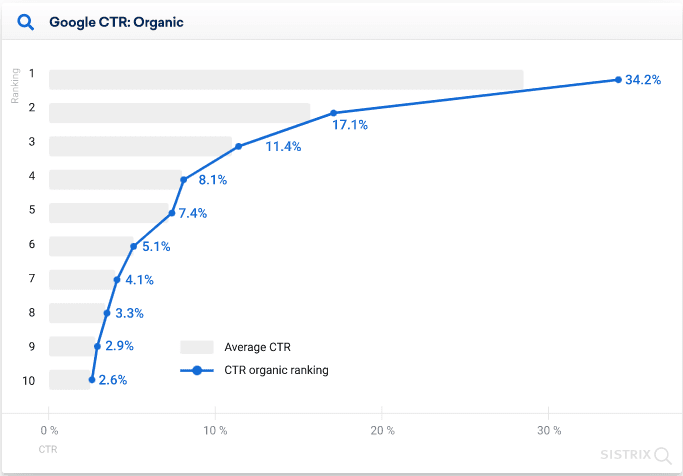
Not bad.
Now let’s take a look at CTR when a search result pulls up a featured snippet.
First, this is a featured snippet:
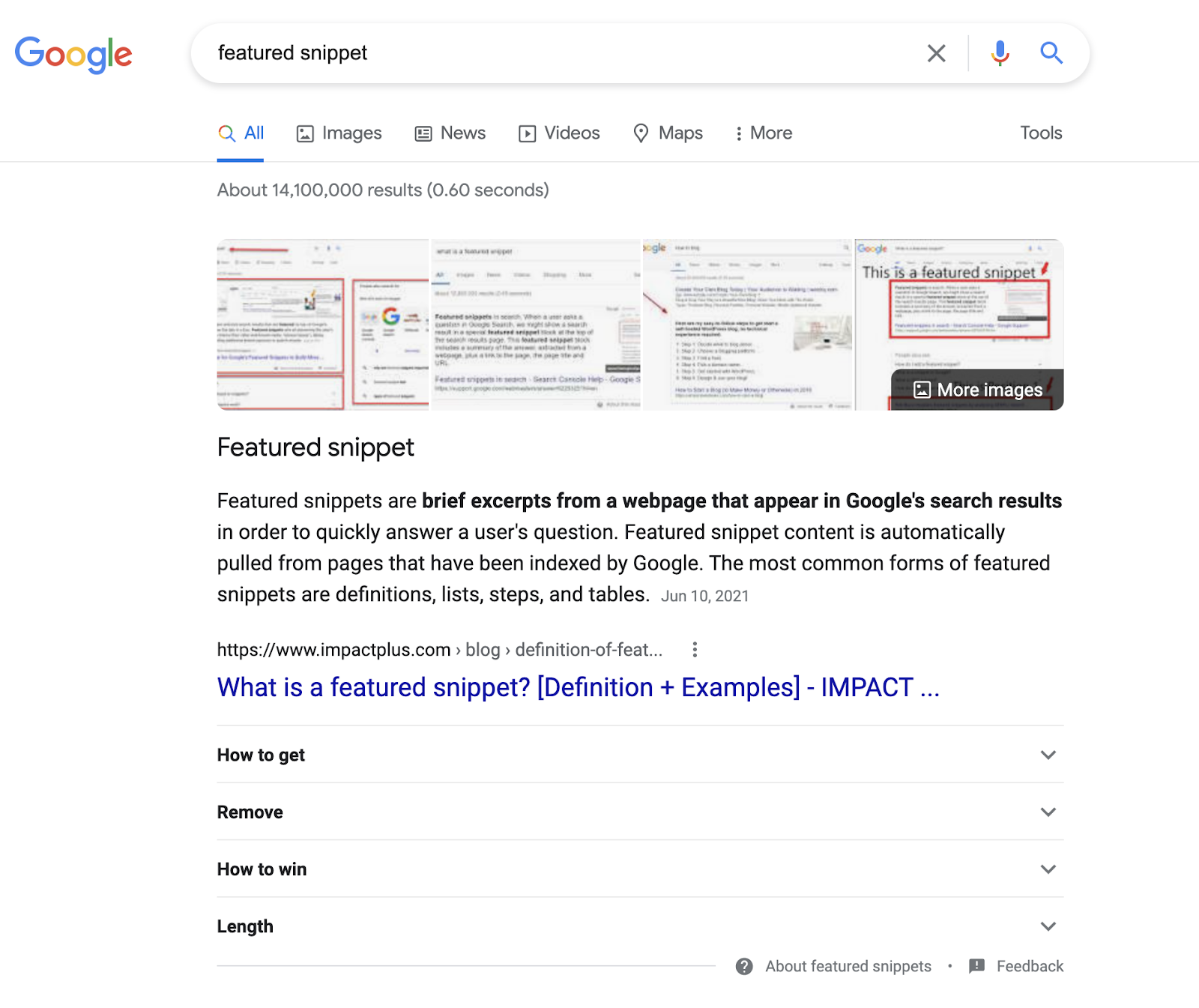
And this is the CTR change when a result has a featured snippet:
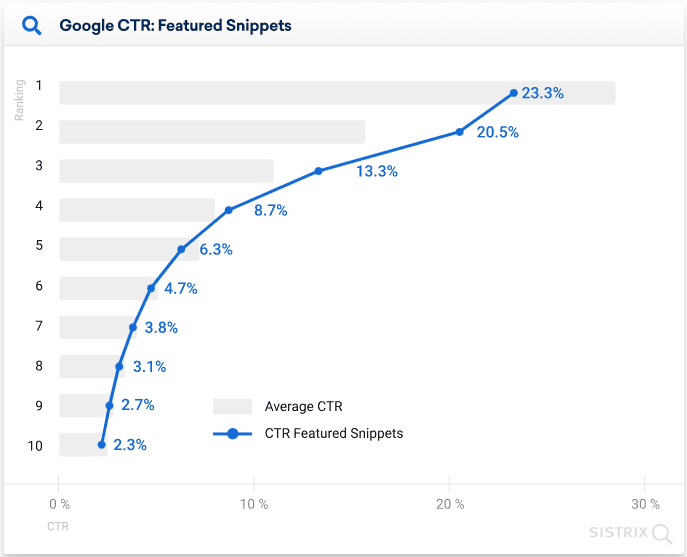
Now what would happen if a search result had a featured snippet, knowledge panel, “people also asked” section, four Google ads above the fold, and a handful of the other 12+ content blocks that might appear in search results?
Suddenly, that average CTR per position would plummet.
So before you commit to a keyword, manually check the SERPs. If it’s loaded with content blocks and featured snippets, that doesn’t mean it’s not worth ranking for necessarily, only that you’re unlikely to receive the average CTR (and estimated organic traffic) a normal result would.
7. Find out if you’re already ranking for it
Do I already rank for it?
Is there a page on your website that already ranks well for a target keyword?
When choosing keywords for SEO, it’s critical that you don’t cannibalize your SEO by creating a new page to rank for a term that an existing page already ranks for organically.
The goal is to choose new keyword phrases for new pages, then optimize old pages for keywords that already rank.
You can use Google’s Search Console (free) to find out which pages rank for which keywords.
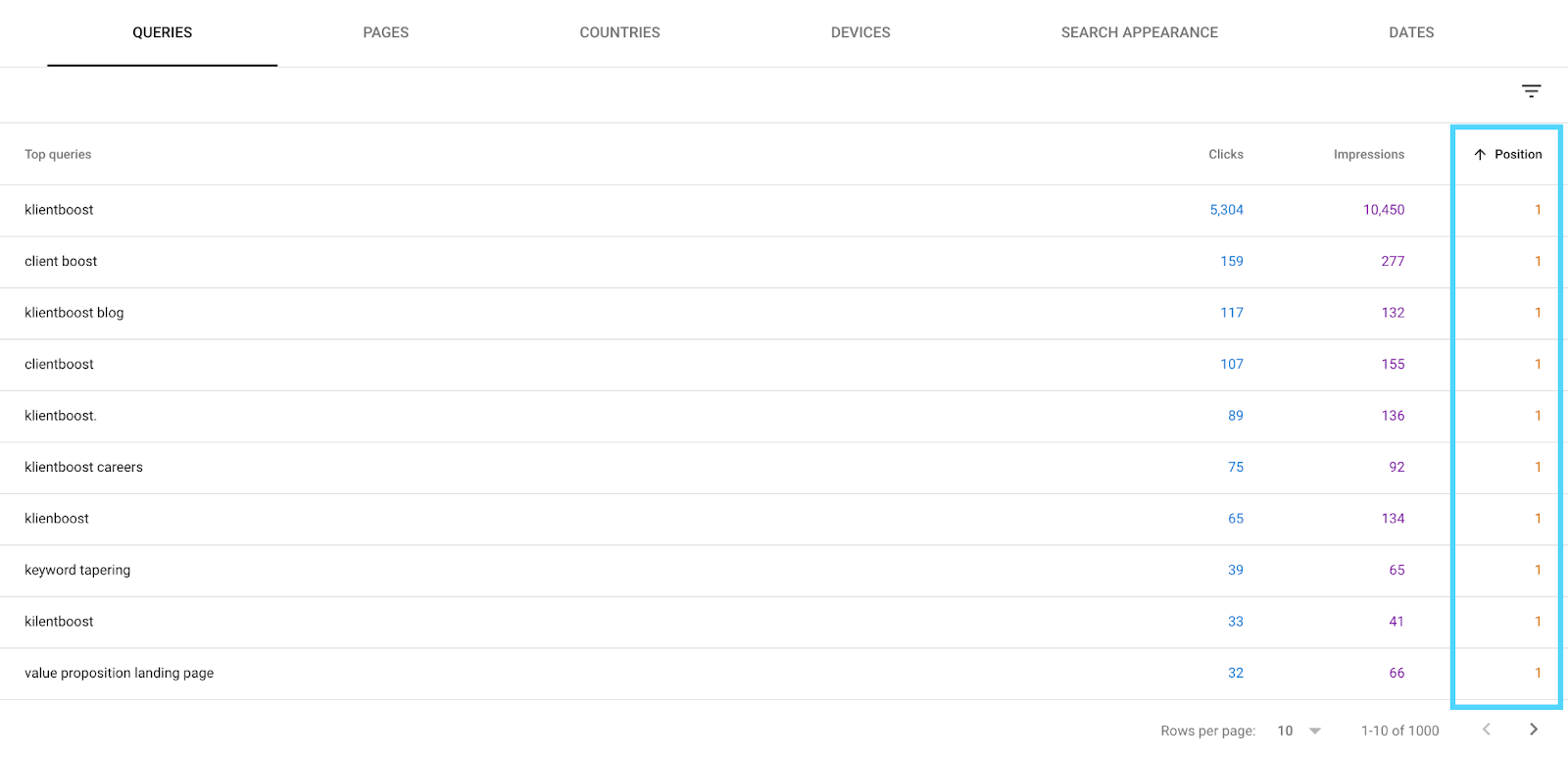
Wrapping up choosing keywords for S
Successful SEO isn’t about how many keywords you choose; it’s about choosing the right keywords in the first place.
Once you have a long list of potential keywords you’d like to pursue, gauge each keyword against the criteria listed in this article:
- Is there adequate search volume for the keyword?
- Is the keyword rankable (not too competitive)?
- Can you satisfy the searcher’s intent?
- Do I have the domain authority to outrank opponents?
- Will it lead to sales now? Or sales later?
- Will you get clicks? Or will Google hoard them?
- Are you already ranking for it?
Now go forth and choose.
